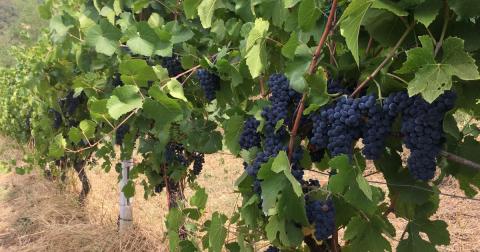Le vigne si trovano a poche centinaia di metri dal castello di Mornico Losana, affacciandosi a nord verso la valle dei Ronchi dove, sulla sommità della collina, si trova il palazzo Isimbardi. Guardando verso est si incrocia il Santuario di Torricella e sullo sfondo le alpi, dove spicca il Monte Rosa.
La sinergia fra il panorama circostante, l'ambiente pedoclimatico e le corrette pratiche agrarie, rendono possibile la produzione di grappoli speciali. Le due etichette "Venti Pertiche" e "Vigna Rondinella" provengono da areali storicamente destinati a vigneto.
I terreni erano coltivati dal nonno Giuseppe, che con tanti sforzi, riuscì ad accorpare piccoli appezzamenti, per formare un corpo unico di 20 pertiche (unità di misura agraria corrispondente a 654 m2). Successivamente, la mia famiglia riuscì ad ampliarlo arrivando a 30 pertiche. La scelta di concentrarsi su quest'area venne intrapresa sulla base dei risultati enologici ottenuti, rispetto ad altre zone che furono vendute.
I vigneti vengono allevati con il sistema di potatura a Guyot*1, che permette di ottenere la migliore qualità dei grappoli, ma comporta molto lavoro manuale in quanto difficile da meccanizzare. Le rese vengono contenute con potature equilibrate aggirandosi attorno ai 5/6 q alla pertica milanese *2.
Dopo la potatura avviene il germogliamento e successivamente lo sviluppo dei tralci, che formeranno la chioma, la sua gestione è un aspetto fondamentale per il bilanciamento della superficie fogliare. Il primo e il secondo passaggio consistono nella sola legatura dei tralci, il primo quando hanno raggiunto una lunghezza di 40/50 cm e il secondo quando hanno una lunghezza di 120cm. Le prime due operazioni hanno lo scopo d'evitare la rottura dei tralci e distribuirli omogeneamente sul filare; l'ultimo passaggio consiste nella cimatura e nell' arrotolamento dei tralci, operato manualmente, per assicurarsi che ogni pianta rispetti specifici rapporti m2 fogliari e kg di uva.
Tutelare la bio-diversità attraverso l'inerbimento del filare è un aspetto fondamentale per la qualità delle uve e per preservare il suolo dall'erosione delle piogge. Il taglio avviene quando l'erba ha raggiunto un'altezza di 40-50 cm. Questo permette di diminuire il numero d'interventi per limitare l'emissione di CO2 e allo stesso tempo di compensarle. Il manto erboso presenta molte specie erbacee, tra le più conosciute troviamo: Tarassaco, Menta, Margherite, Viole, Convolvolo, Aglio selvatico e tante altre.
La raccolta viene praticata manualmente, riempiendo delle piccole tramogge da 400 kg. Queste uve vengono pigiate dopo solo 50 minuti dalla raccolta del primo grappolo, mantenendo integri tutti gli aromi e le qualità organolettiche.
La vinificazione
Le uve di Pinot nero (Cloni 777 e VCR18) per "Vigna Rondinella" e Croatina, Barbera, Uva rara per "Venti Pertiche" vengono diraspate, nella piccola cantina adiacente al castello.
Il mosto ottenuto, contenente bucce e vinaccioli*3, viene raccolto in contenitori di piccole dimensioni, dove avviene la fermentazione alcolica, condotta a temperatura controllata, con lieviti selezionati*4 a bassissime dosi di solfiti. Si è scelto di non usare lieviti indigeni*5, perché i cambiamenti climatici fanno sì, che il tenore alcolico sia sempre superiore al 13 %vol, perciò la presenza di lieviti non efficienti porterebbe all'innalzamento dell'acidità volatile o peggio una fermentazione parziale degli zuccheri. Il controllo della temperatura è fondamentale per evitare estrazioni di tannini troppo astringenti, che porterebbero ad un vino "spigoloso".
Nella prima fase fermentativa avvengono i rimontaggi e le follature manuali, operazioni che favoriscono l'estrazione di: polifenoli*6, sostanze aromatiche*7 e tannini*8. La follatura consiste nella rottura del cappello tramite un'asta, facendolo affondare nel mosto-vino. Il cappello è formato dalle bucce spinte in superficie dalla CO2, prodotta naturalmente dalla fermentazione. Nel rimontaggio sì preleva il mosto-vino della parte bassa della vasca per bagnare il cappello con molteplici benefici:
● abbassamento della temperatura
● estrazione delle sostanze dalle bucce
● evitare che si formino zone, sopra il cappello, dove si instaurino inizi di fermentazioni acetiche
Dopo circa 10 giorni di fermentazione a contatto con le bucce per il "Vigna Rondinella" e 6-7 giorni per "Venti Pertiche", avviene la svinatura dove si separa il liquido dal solido. La fermentazione in seguito continuerà fino a che tutti gli zuccheri non saranno stati trasformati in alcol. Terminata la fase fermentativa iniziano i travasi, pratica enologica adottata per separare le particelle più grossolane per decantazione. Finita la fermentazione avviene un altro importante processo biochimico: la fermentazione Mallolattica*9.
Si innesta naturalmente grazie a batteri mallolattici, che non sono inoculati ma naturalmente presenti, lasciati in eredità dalle precedenti vinificazioni del nonno Giuseppe. La Mallollattica trasforma l'acido malico in acido Lattico donando morbidezza, eleganza e una notevole stabilita micro biologica.
Tutti i processi bio-chimici finiscono verso la fine della primavera successiva alla vendemmia, dopo di che siamo pronti per i primi imbottigliamenti. Che verranno completati nel mese di novembre - dicembre.
*1 Guyot: sistema d'allevamento che prevende un capo a frutto e uno sperone, il capo a frutto produrrà l'uva per l'anno presente mentre dallo sperone prenderà origine il capo a frutto per l'anno futuro.
*2 Pertica milanese: unità di misura corrispondente a 654 m2.
*3 Vinaccioli: sono i semi dell'acino d'uva.
*4 Lieviti selezionati: solo lieviti appartenenti alla famiglia dei Saccharomyces cerevisiae. Sono stati selezionati in natura per avere bassissima produzione d'acido acetico ed esaltare gli aromi preservandoli da stress ossidativi.
*5 Lieviti indigeni: sono lieviti appartenenti alla micro flora presente sugli acini, composta da molte specie di lieviti come Saccharomyces cerevisiae, Brettanomyces Bruxellensis, Kloecker.
*6 Polifenoli: sostanze coloranti del vino rosso.
*7Terpeni: composti aromatici che conferiscono profumi di fiori o frutta al vino. Alcune molecole sono: geraniolo, linalolo, nerolo, ecc.
*8 Tannini: vengono estratti dai vinaccioli e sono tannini che hanno la loro struttura caratterizzata dalla Catechina. Quest'utima è in grado di far condensare le proteine presenti nella saliva producendo il gusto astringente.
*9 Mallolattica: processo bio-chimico che trasforma l'acido Malico in acido lattico, operato da batteri Mallolattici.








